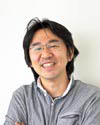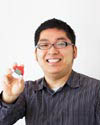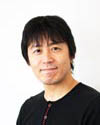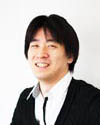Go Behind the Scenes with the Pokémon Masters at Game Freak, Inc!

| The following is a transcription of an interview conducted by the Official Pokémon website. It was originally posted on Mar 31, 2010. |
Meet the Pokémon developers and learn what goes into making such incredible games!
Recently, we had the rare opportunity to discuss Pokémon HeartGold and SoulSilver Versions with some very knowledgable people: the developers at GAME FREAK, inc. The six developers took time out to provide some insight into topics surrounding the games.
It has been ten years since the original Pokémon Gold and Silver versions. What has changed in that time with regards to your approach to game design and what has remained the same?






Left to Right: Junichi Masuda, Kenji Matsushima, Akito Mori, Shigeki Morimoto, Shigeru Ohmori, Takao Unno
Junichi Masuda, Director: Because of the hardware, our game design has changed dramatically. Really, I didn’t think of the Internet ten years ago! (laughs) Also, the quality of both picture and sound have dramatically advanced in that time—the number of colors and three-dimensional graphics, for instance, has greatly expanded. Of course, that made things harder! (laughs) One thing which hasn’t changed is our desire to create a game that is approachable for everyone.
Shigeki Morimoto, Game Director: It’s also worth noting that what has changed was that more people are now involved in the development. As a result, there are a lot of things we can do, but now we need somebody who can lead and hold the team together. Our passion for game creation has remained the same.
Kenji Matsushima, Planner: Some things that have never changed are the basic, fun elements of the Pokémon games—collecting, battling, and trading—as well as the Pokémon themselves. But on the other hand, one primary thing that has changed is that new ideas come up due to the technical advances in the hardware.
Shigeru Ohmori, Planner: When Gold and Silver launched, I was a student, and I played the game intensely. I never thought I would be involved in Pokémon game development. For me personally, this has been a huge change. I still have vivid memories of playing those games, and it encourages me to do my best to make an even better game for future players.
Akito Mori, Programming Lead: Most players will know that one thing that has changed is that the number of Pokémon has doubled— as a result, the data sizes have increased as well. This means we that need to make sure that one new idea is not going to affect any other Pokémon data. But one thing that has never changed is that we are a group of "Game Freaks," just like our company name says.
Takao Unno, Art Director: As we’ve noted, we are now able to express various aspects of the games differently thanks to the technological advancement of the hardware. However, our stance on precisely what new technology can be utilized hasn’t changed. We do not use all available technology—instead, we select those that are best for the players and those that make the gameplay more compelling.
It's unusual for a game to be very popular both in Japan and in the United States (and for that matter, in Europe). What makes Pokémon so universally enjoyed?
Masuda: First of all, it is not just a game series that simply presents the Pokémon world, characters, and scenarios. It is the entire gameplay experience that goes way beyond the borders. For instance, let’s take a universal play mechanic like throwing and catching a ball. Children from different countries can play that game right away. But now let’s consider another example: sports. Both of these share the same thing, and that’s gameplay. In Pokémon games, it is a game in which a player encounters Pokémon that have jumped out of the bushes, a game in which a player battles with a Pokémon and catches it, and a game in which a player can battle against other Trainers. Those are the basics. But then you have characters, scenarios, Pokédex, Items, moves, Trainers, and Rivals are intertwined with this basic gameplay. So, to answer your question, what makes Pokémon so universally enjoyed? It is because at the core of all our titles is gameplay.
The Pokéwalker is not the first time Pokémon has made an accessory for the games . What do you like about the Pokéwalker concept that made you decide to add one to this game?
Ohmori: The idea came up when we thought about what we could do to make players’ dream—"I would like to become a real Pokémon Trainer!"—possible. Our focus was on enabling a player to be with his or her Pokémon all the time, even when just walking around. Because you can play anytime, anywhere, it seems like as many players play with their Pokéwalkers as play the actual games. I am happy to see that.
American gamers are becoming more interested in the development of the games they love. Can you give some insight into what it takes to make games like Pokémon HeartGold and SoulSilver Versions?
Morimoto: Heart and Soul! (laughs) It took just under three years to develop and about twenty people were involved.
Are there any particular areas or locations in Pokémon HeartGold and SoulSilver Versions that you are proud of or had a lot of fun developing? Any insider tips on what gamers definitely watch for or locations they absolutely must travel to?
Morimoto: My favorite place is Ecruteak City. It was the first town/city that we created for HeartGold and SoulSilver.
Matsushima: The Pokémon world is unique because of the liveliness of the Pokémon. And in HeartGold and SoulSilver, you can walk with Pokémon. I encourage players to try to walk with a wide variety of Pokémon. Travel around so you can meet the main characters, such as the Gym Leaders who appear in different parts of the regions. And there are various events in which you’ll earn their friendship.
Mori: I was in charge of "environmental sounds" for the new games. So, I highly recommend players listen to the sound of the swinging columns of Sprout Tower. In earthquake-prone Japan, using very flexible materials to support buildings is very common, and I think I was able to express that sound in a very realistic way.
Ohmori: Definitely the new facility called the Pokéathlon Dome. This didn’t exist in Gold and Silver, and players can enjoy new and different gameplay styles with your Pokémon there. Hopefully players will try it with all of their different Pokémon.
Unno: I would like players to check out all parts of HeartGold and SoulSilver world, but the most sentimental place for me is the Bellchime Trail, leading to the Bell Tower. Players will see how beautiful the turning-leaf graphics are. I recommend every player takes his or her favorite Pokémon there and enjoy the walk!
The Pokémon Video Game Championships are becoming more popular each year. Would you like to see other aspects of the Pokémon games become a part of the competitions?
Morimoto: Ah, yes—the Pokéathlon. The battles there could get very heated. I would love to see players enjoying this with my own eyes.
Matsushima: Absolutely, the Pokéathlon, of course! I am sure it’ll be very exciting!
Ohmori: I would like to see a Pokéathlon competition, too. At our company, we all enjoyed competing against each other. It would be great if we could see such a tournament! I am also very curious to see which Pokémon will ultimately be popular in the Pokéathlon.
Unno: Or how about a fishing competition at the Lake of Rage? Who would catch a biggest Magikarp in the time limit? That would be fun!
Mori: And battling at the Pokémon League with your Lv.50 Pokémon without auto-healing between rounds. You could see how long it takes to get to the end. On second thought, that may not be a very good competition. (laughs)
You work on the Pokémon video games. Do you also take time to catch up on the TV episodes and play the TCG? How do they reflect what you do during game development?
Morimoto: Yes, of course, I watch the TV episodes and play the Pokémon Trading Card Game. Sometimes I draw inspiration for expressions, stages, and move names that I use in game development from them.
Masuda: Of course, I also watch TV episodes and go to see the movies—many times, in fact. They are close to video games in their style, and we are personally quite close to the staff that creates the animations. For example, we might say, "let’s do it this way in the game" because it was like that in a movie. Or we might go to a TCG tournament and see the excitement there, which leads us to think about how we can we do the same for the video game. I think all of the Pokémon pillars stimulate each other and resonate across all of them. That is actually the most compelling aspect of Pokémon.
Matsushima: In addition, there are a lot of hints I get from the TV shows, such as how a Pokémon moves or how abilities are described in the show. It is a very good reference.
Ohmori: The Pokémon TV shows and the Pokémon Trading Card Game appeal to audiences differently than video games do. I am particularly interested in how they influence the Pokémon world. For instance, depending on the media, different Pokémon are more popular. Those differences make the Pokémon world both broader and deeper. So, I like to consider new gameplay using communication tools that closely connect these media.
Mori: It is difficult to watch all the episodes, but I still like to watch them one by one. I appreciate the fact that Pokémon are described so vividly in the show; eventually, we would like to express its vividness in the video games. And I’ve played the Pokémon Trading Card Game, but I can’t win at all!
Unno: Of course, I enjoy both! I feel like I can relate to our players by experiencing the games myself. It makes it possible for me to see things differently and to develop new gameplay. On the other hand, I work on the game design often wishing that it could be applied to the animation or the TCG.
Thanks to the developers at GAME FREAK, inc. for giving their time to give us an in-depth look at Pokémon HeartGold and SoulSilver Versions!
This page has been viewed 9523 times.
Last updated 03 Oct 2012 20:42
by Sunain.
Revision #7
Revision #7
Page Tags:
Interview












